Burcu Karagol Ayan
Heterogenous graph neural networks for species distribution modeling
Mar 14, 2025Abstract:Species distribution models (SDMs) are necessary for measuring and predicting occurrences and habitat suitability of species and their relationship with environmental factors. We introduce a novel presence-only SDM with graph neural networks (GNN). In our model, species and locations are treated as two distinct node sets, and the learning task is predicting detection records as the edges that connect locations to species. Using GNN for SDM allows us to model fine-grained interactions between species and the environment. We evaluate the potential of this methodology on the six-region dataset compiled by National Center for Ecological Analysis and Synthesis (NCEAS) for benchmarking SDMs. For each of the regions, the heterogeneous GNN model is comparable to or outperforms previously-benchmarked single-species SDMs as well as a feed-forward neural network baseline model.
Imagen 3
Aug 13, 2024Abstract:We introduce Imagen 3, a latent diffusion model that generates high quality images from text prompts. We describe our quality and responsibility evaluations. Imagen 3 is preferred over other state-of-the-art (SOTA) models at the time of evaluation. In addition, we discuss issues around safety and representation, as well as methods we used to minimize the potential harm of our models.
ImageInWords: Unlocking Hyper-Detailed Image Descriptions
May 05, 2024Abstract:Despite the longstanding adage "an image is worth a thousand words," creating accurate and hyper-detailed image descriptions for training Vision-Language models remains challenging. Current datasets typically have web-scraped descriptions that are short, low-granularity, and often contain details unrelated to the visual content. As a result, models trained on such data generate descriptions replete with missing information, visual inconsistencies, and hallucinations. To address these issues, we introduce ImageInWords (IIW), a carefully designed human-in-the-loop annotation framework for curating hyper-detailed image descriptions and a new dataset resulting from this process. We validate the framework through evaluations focused on the quality of the dataset and its utility for fine-tuning with considerations for readability, comprehensiveness, specificity, hallucinations, and human-likeness. Our dataset significantly improves across these dimensions compared to recently released datasets (+66%) and GPT-4V outputs (+48%). Furthermore, models fine-tuned with IIW data excel by +31% against prior work along the same human evaluation dimensions. Given our fine-tuned models, we also evaluate text-to-image generation and vision-language reasoning. Our model's descriptions can generate images closest to the original, as judged by both automated and human metrics. We also find our model produces more compositionally rich descriptions, outperforming the best baseline by up to 6% on ARO, SVO-Probes, and Winoground datasets.
Harm Amplification in Text-to-Image Models
Feb 01, 2024



Abstract:Text-to-image (T2I) models have emerged as a significant advancement in generative AI; however, there exist safety concerns regarding their potential to produce harmful image outputs even when users input seemingly safe prompts. This phenomenon, where T2I models generate harmful representations that were not explicit in the input, poses a potentially greater risk than adversarial prompts, leaving users unintentionally exposed to harms. Our paper addresses this issue by first introducing a formal definition for this phenomenon, termed harm amplification. We further contribute to the field by developing methodologies to quantify harm amplification in which we consider the harm of the model output in the context of user input. We then empirically examine how to apply these different methodologies to simulate real-world deployment scenarios including a quantification of disparate impacts across genders resulting from harm amplification. Together, our work aims to offer researchers tools to comprehensively address safety challenges in T2I systems and contribute to the responsible deployment of generative AI models.
PaLI: A Jointly-Scaled Multilingual Language-Image Model
Sep 16, 2022
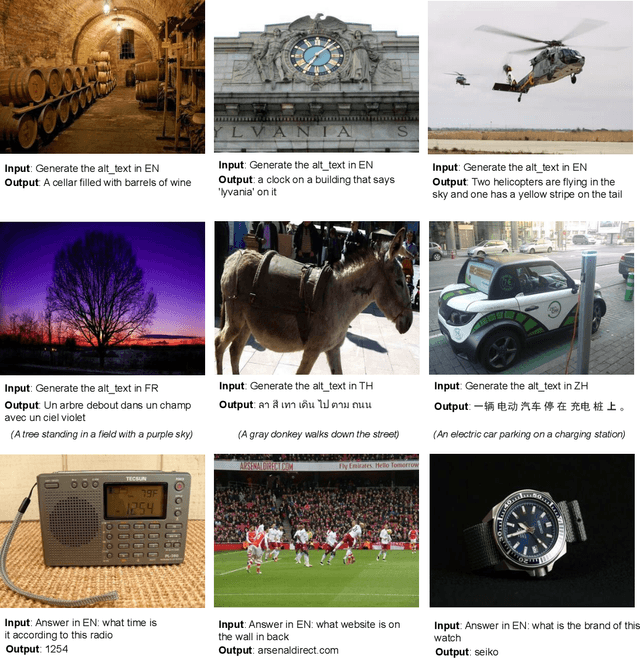
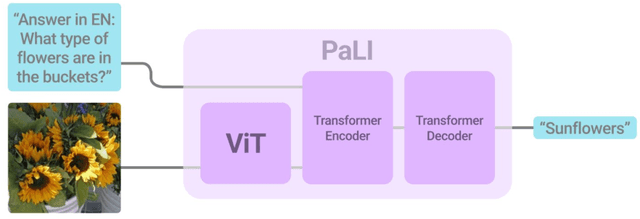

Abstract:Effective scaling and a flexible task interface enable large language models to excel at many tasks. PaLI (Pathways Language and Image model) extends this approach to the joint modeling of language and vision. PaLI generates text based on visual and textual inputs, and with this interface performs many vision, language, and multimodal tasks, in many languages. To train PaLI, we make use of large pretrained encoder-decoder language models and Vision Transformers (ViTs). This allows us to capitalize on their existing capabilities and leverage the substantial cost of training them. We find that joint scaling of the vision and language components is important. Since existing Transformers for language are much larger than their vision counterparts, we train the largest ViT to date (ViT-e) to quantify the benefits from even larger-capacity vision models. To train PaLI, we create a large multilingual mix of pretraining tasks, based on a new image-text training set containing 10B images and texts in over 100 languages. PaLI achieves state-of-the-art in multiple vision and language tasks (such as captioning, visual question-answering, scene-text understanding), while retaining a simple, modular, and scalable design.
Scaling Autoregressive Models for Content-Rich Text-to-Image Generation
Jun 22, 2022
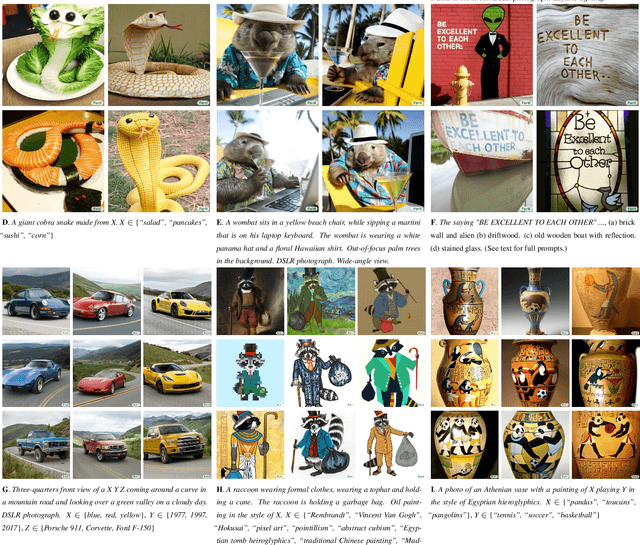

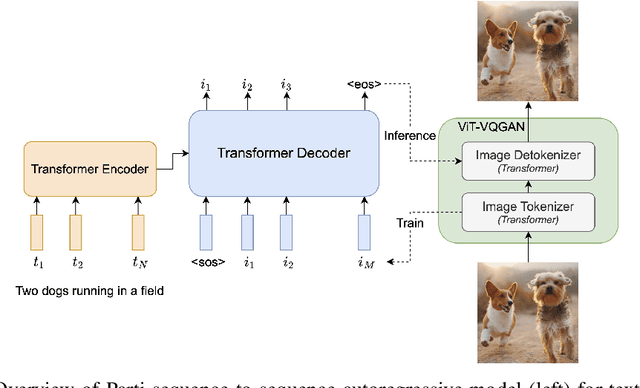
Abstract:We present the Pathways Autoregressive Text-to-Image (Parti) model, which generates high-fidelity photorealistic images and supports content-rich synthesis involving complex compositions and world knowledge. Parti treats text-to-image generation as a sequence-to-sequence modeling problem, akin to machine translation, with sequences of image tokens as the target outputs rather than text tokens in another language. This strategy can naturally tap into the rich body of prior work on large language models, which have seen continued advances in capabilities and performance through scaling data and model sizes. Our approach is simple: First, Parti uses a Transformer-based image tokenizer, ViT-VQGAN, to encode images as sequences of discrete tokens. Second, we achieve consistent quality improvements by scaling the encoder-decoder Transformer model up to 20B parameters, with a new state-of-the-art zero-shot FID score of 7.23 and finetuned FID score of 3.22 on MS-COCO. Our detailed analysis on Localized Narratives as well as PartiPrompts (P2), a new holistic benchmark of over 1600 English prompts, demonstrate the effectiveness of Parti across a wide variety of categories and difficulty aspects. We also explore and highlight limitations of our models in order to define and exemplify key areas of focus for further improvements. See https://parti.research.google/ for high-resolution images.
Photorealistic Text-to-Image Diffusion Models with Deep Language Understanding
May 23, 2022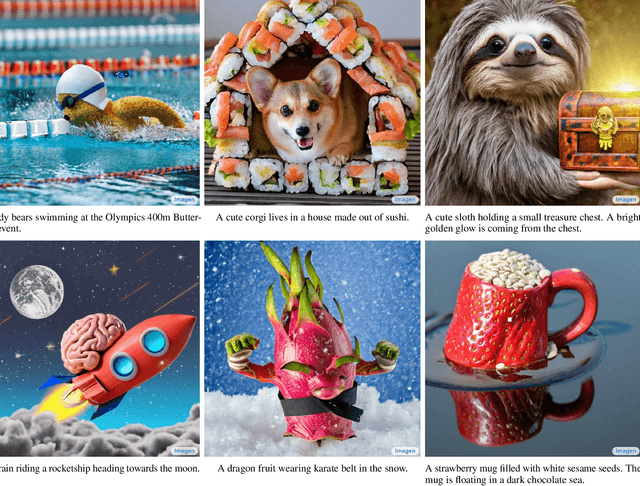
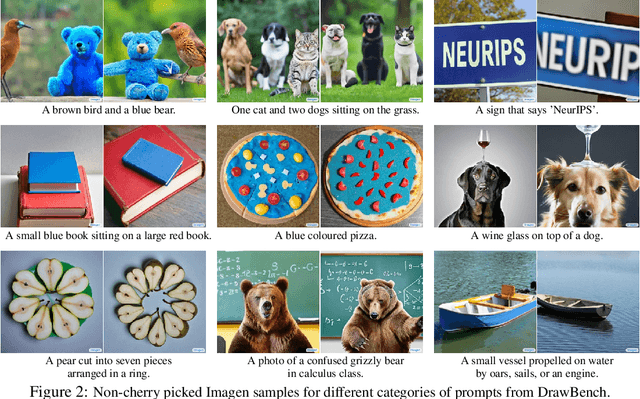
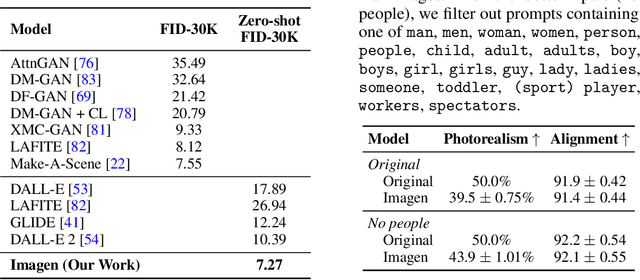

Abstract:We present Imagen, a text-to-image diffusion model with an unprecedented degree of photorealism and a deep level of language understanding. Imagen builds on the power of large transformer language models in understanding text and hinges on the strength of diffusion models in high-fidelity image generation. Our key discovery is that generic large language models (e.g. T5), pretrained on text-only corpora, are surprisingly effective at encoding text for image synthesis: increasing the size of the language model in Imagen boosts both sample fidelity and image-text alignment much more than increasing the size of the image diffusion model. Imagen achieves a new state-of-the-art FID score of 7.27 on the COCO dataset, without ever training on COCO, and human raters find Imagen samples to be on par with the COCO data itself in image-text alignment. To assess text-to-image models in greater depth, we introduce DrawBench, a comprehensive and challenging benchmark for text-to-image models. With DrawBench, we compare Imagen with recent methods including VQ-GAN+CLIP, Latent Diffusion Models, and DALL-E 2, and find that human raters prefer Imagen over other models in side-by-side comparisons, both in terms of sample quality and image-text alignment. See https://imagen.research.google/ for an overview of the results.
Which Linguist Invented the Lightbulb? Presupposition Verification for Question-Answering
Jan 02, 2021



Abstract:Many Question-Answering (QA) datasets contain unanswerable questions, but their treatment in QA systems remains primitive. Our analysis of the Natural Questions (Kwiatkowski et al. 2019) dataset reveals that a substantial portion of unanswerable questions ($\sim$21%) can be explained based on the presence of unverifiable presuppositions. We discuss the shortcomings of current models in handling such questions, and describe how an improved system could handle them. Through a user preference study, we demonstrate that the oracle behavior of our proposed system that provides responses based on presupposition failure is preferred over the oracle behavior of existing QA systems. Then we discuss how our proposed system could be implemented, presenting a novel framework that breaks down the problem into three steps: presupposition generation, presupposition verification and explanation generation. We report our progress in tackling each subproblem, and present a preliminary approach to integrating these steps into an existing QA system. We find that adding presuppositions and their verifiability to an existing model yields modest gains in downstream performance and unanswerability detection. The biggest bottleneck is the verification component, which needs to be substantially improved for the integrated system to approach ideal behavior -- even transfer from the best entailment models currently falls short.
Text Classification with Few Examples using Controlled Generalization
May 18, 2020
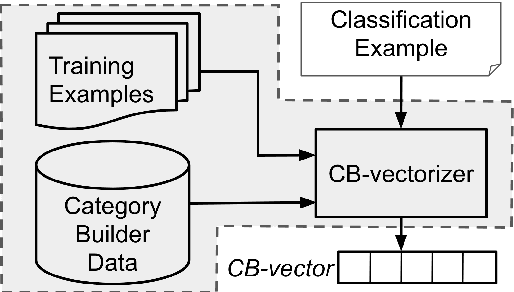
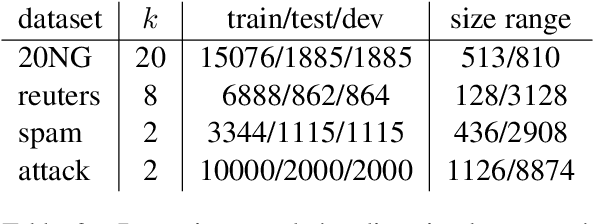
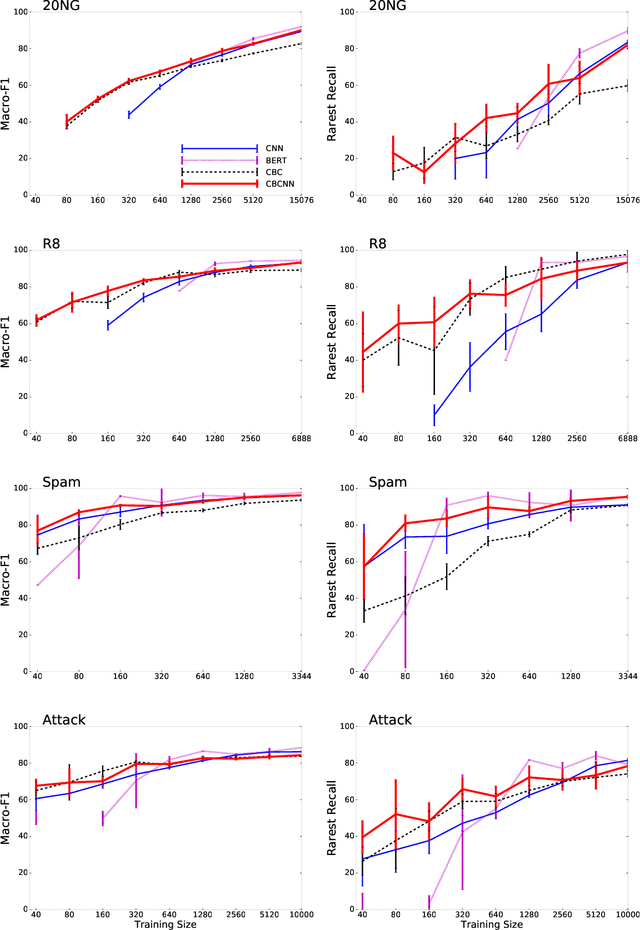
Abstract:Training data for text classification is often limited in practice, especially for applications with many output classes or involving many related classification problems. This means classifiers must generalize from limited evidence, but the manner and extent of generalization is task dependent. Current practice primarily relies on pre-trained word embeddings to map words unseen in training to similar seen ones. Unfortunately, this squishes many components of meaning into highly restricted capacity. Our alternative begins with sparse pre-trained representations derived from unlabeled parsed corpora; based on the available training data, we select features that offers the relevant generalizations. This produces task-specific semantic vectors; here, we show that a feed-forward network over these vectors is especially effective in low-data scenarios, compared to existing state-of-the-art methods. By further pairing this network with a convolutional neural network, we keep this edge in low data scenarios and remain competitive when using full training sets.
Context-Based Quotation Recommendation
May 17, 2020



Abstract:While composing a new document, anything from a news article to an email or essay, authors often utilize direct quotes from a variety of sources. Although an author may know what point they would like to make, selecting an appropriate quote for the specific context may be time-consuming and difficult. We therefore propose a novel context-aware quote recommendation system which utilizes the content an author has already written to generate a ranked list of quotable paragraphs and spans of tokens from a given source document. We approach quote recommendation as a variant of open-domain question answering and adapt the state-of-the-art BERT-based methods from open-QA to our task. We conduct experiments on a collection of speech transcripts and associated news articles, evaluating models' paragraph ranking and span prediction performances. Our experiments confirm the strong performance of BERT-based methods on this task, which outperform bag-of-words and neural ranking baselines by more than 30% relative across all ranking metrics. Qualitative analyses show the difficulty of the paragraph and span recommendation tasks and confirm the quotability of the best BERT model's predictions, even if they are not the true selected quotes from the original news articles.
 Add to Chrome
Add to Chrome Add to Firefox
Add to Firefox Add to Edge
Add to Edge